23 Skin Lesions and How To Identify Them
Medically reviewed by William Truswell, MD
Sensitive Content: Medical Images Included
This article contains medical images of skin lesions.
A skin lesion is an abnormal change to the skin or area of skin that's different from the surrounding skin. Skin lesions can be smooth or textured, symmetric or irregularly shaped, and large or small. Some might cause itching or pain, while others might not be bothersome at all. A healthcare provider may need to remove a skin lesion if it's bothersome, precancerous, or cancerous.
Most skin lesions are benign, but some can be cancerous. Read on to learn about skin lesions, including what they are, symptoms, causes, and treatment.

Getty Images
Related: 5 Types of Warts You Might Get
What Are Skin Lesions?
Skin lesions are generally classified into two categories: primary and secondary. Primary skin lesions can be present from birth or develop later in life. Examples include birthmarks, moles, and acne. Secondary skin lesions, in contrast, result from an irritated primary skin lesion. An example could be a mole you scratched that bleeds and crusts over.
Freckles
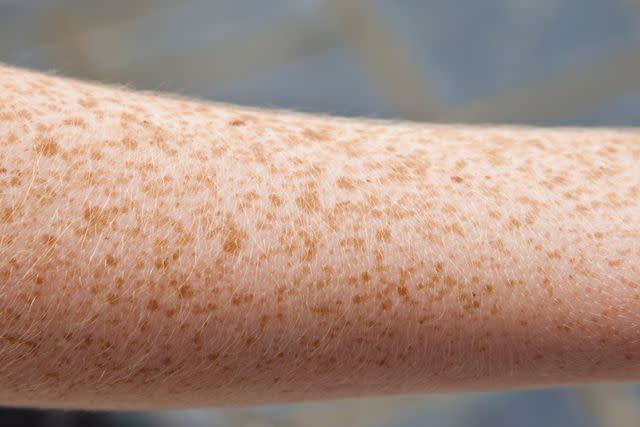
Getty Images
Sun exposure prompts the production of melanin (pigment). You may notice small, flat brown dots on the skin, or freckles. Freckles are typically harmless and do not require treatment.
Moles
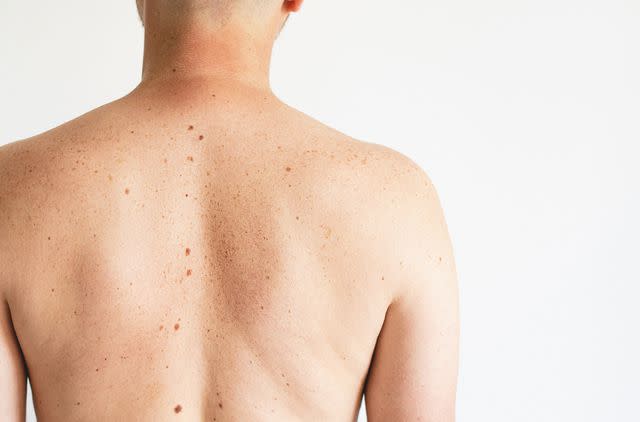
Getty Images
Flat moles, which are bigger than freckles, develop when your skin's pigment cells (melanocytes) grow together. Moles can be brown, tan, or pink in shade, depending on your skin tone.
Common moles can have characteristics, such as:
Defined border
Dome-shaped
Round or oval in shape
Smooth texture
It's unlikely that a common mole would turn into melanoma (the most severe form of skin cancer). Atypical moles are more likely to be cancerous. Atypical moles are usually bigger than common moles. These moles might have irregular edges and be a mix of colors.
Dark Spots
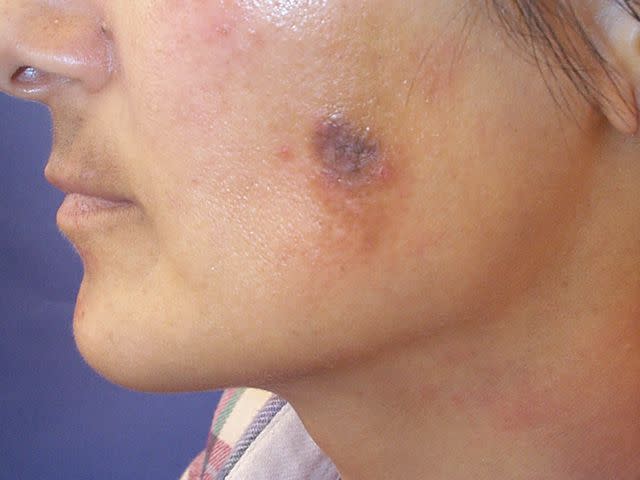
DermNet
Dark spots (post-inflammatory hyperpigmentation) can develop after acne clears up, medication use, or hormone changes. These spots tend to be common among people with darker skin tones due to the skin's melanin production process. You can treat dark spots, but they can return without continued treatment (e.g., not wearing sunscreen).
Vesicles
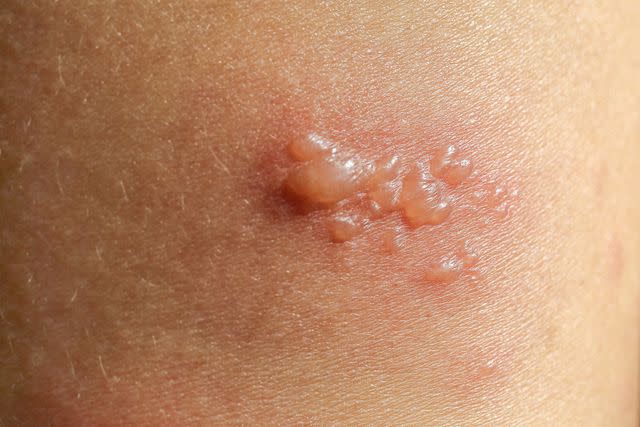
Getty Images
Vesicles, tiny fluid-filled blisters, are usually no larger than 1 centimeter (cm). These skin lesions may develop in a rash-like formation, often alongside allergic reactions and infections. Vesicles may require treatment, depending on the underlying cause.
Bullae
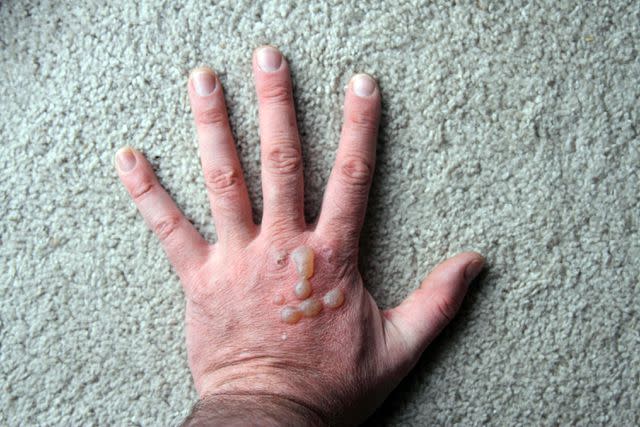
Getty Images
Bullae are large blisters filled with clear fluid or blood and are typically bigger than 1 cm. Friction, infection, or inflammation cause bullae. These skin lesions tend to go away on their own.
Warts
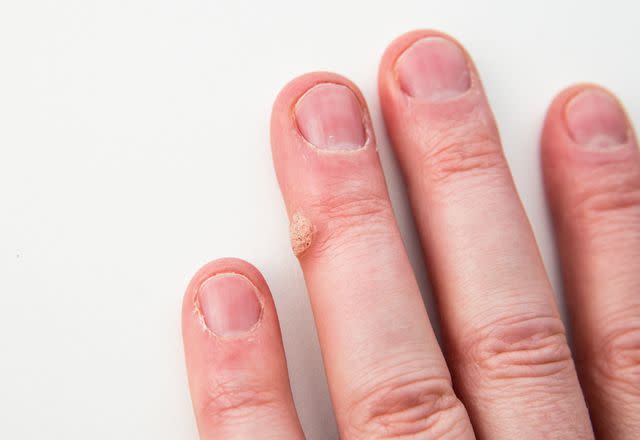
Getty Images
Warts are small, flat, noncancerous growths caused by human papillomavirus (HPV). Where the warts develop depends on the strain of HPV, but they commonly affect the hands, feet, and genitals. Warts may go away on their own, but a healthcare provider can remove them if needed.
Acne Papule
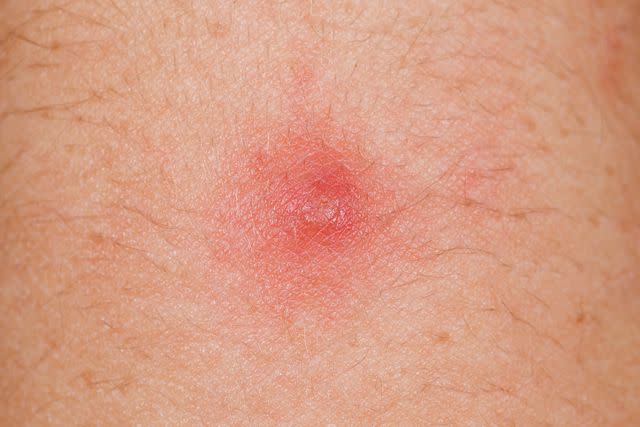
Getty Images
This common type of skin lesion is a small, hard, inflamed (and sometimes red) bump. A pimple can pop up thanks to excess sebum (oil), bacteria, and dead skin cells.
Actinic Keratosis (AK)
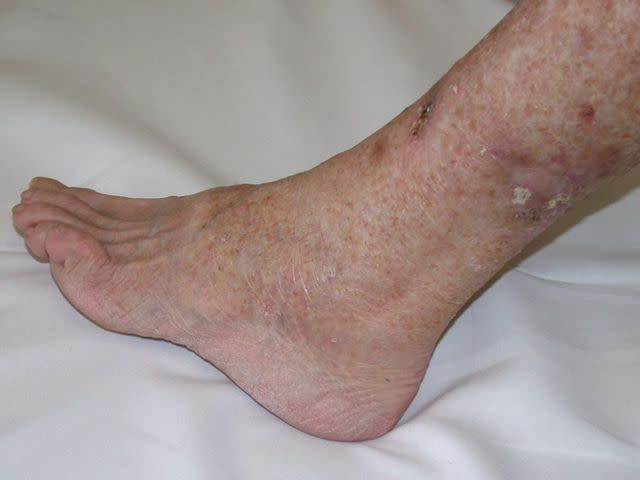
DermNet
Actinic keratosis (AK) is one of the most common precancerous skin growths that develop as a result of repeated sun exposure. These scaly papules are rough-feeling and can be brown, tan, white, red, pink, or skin-colored. AKs often itch and scab over.
Psoriasis Plaques
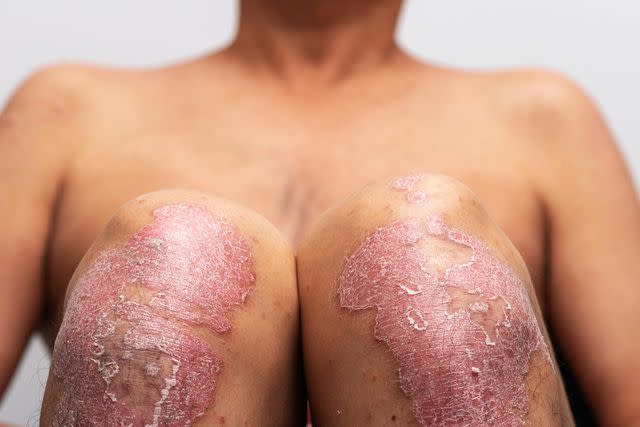
Getty Images
These plaques develop with the psoriasis, a chronic (long-lasting) skin condition. Psoriasis causes thick, silvery patches that often show up on the elbows, knees, scalp, and lower back.
Cysts
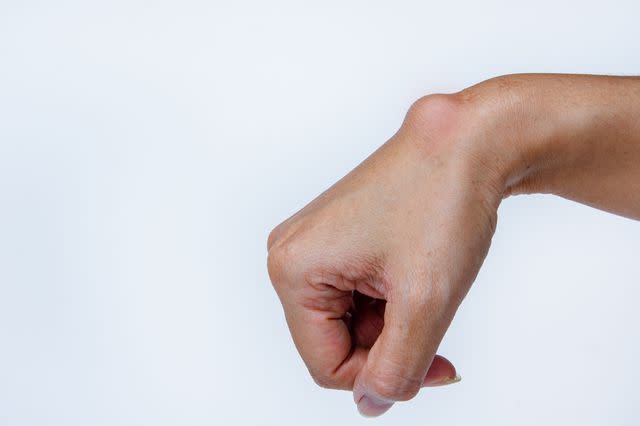
Getty Images
Cysts are closed pockets of tissue filled with fluid, air, or pus. These skin lesions can develop nearly anywhere on the body. A healthcare provider might need to remove cysts, particularly if they suspect cancer.
Lipomas
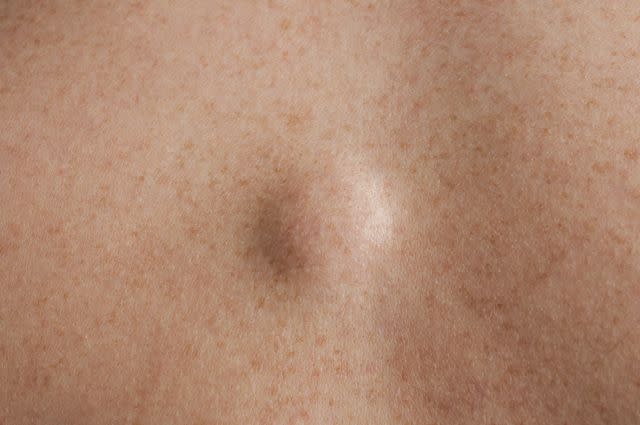
Getty Images
Lipomas usually develop slowly beneath the skin. These noncancerous growths are made up of fatty tissue cells and might cause discomfort depending on their location.
Acne Pustule
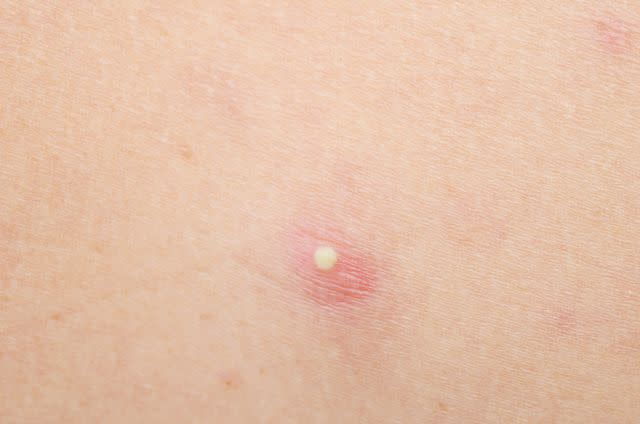
Getty Images
A whitehead is an example of an acne pustule. Whiteheads are characterized by a white tip filled with pus.
Folliculitis
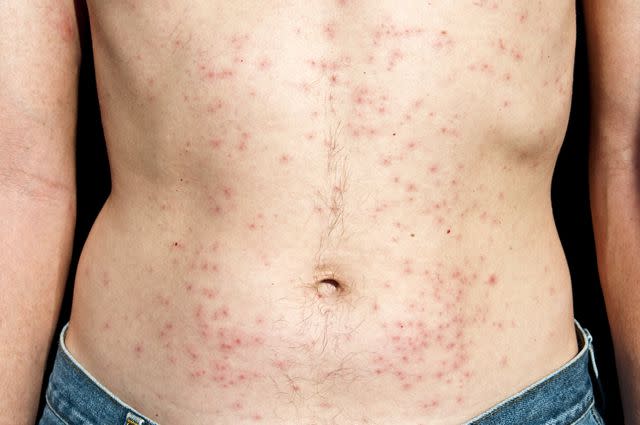
Getty Images
Inflamed hair follicles develop into pustules called folliculitis. These pustules commonly form around the genital area and on the neck.
Insect Bites
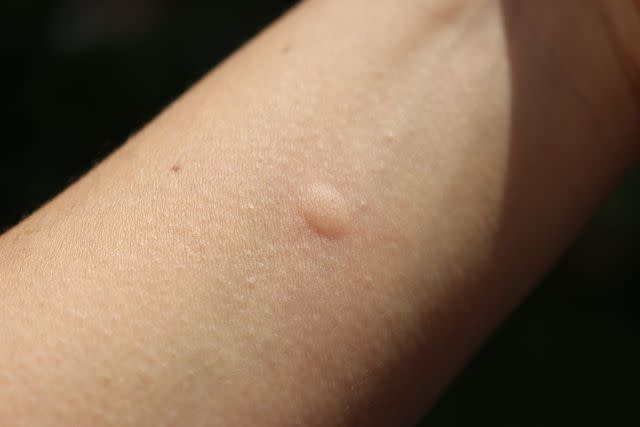
Getty Images
A raised, itchy bump sometimes appears if your immune system reacts to saliva from an insect bite, like from a mosquito. Insect bites often go away on their own.
Hives
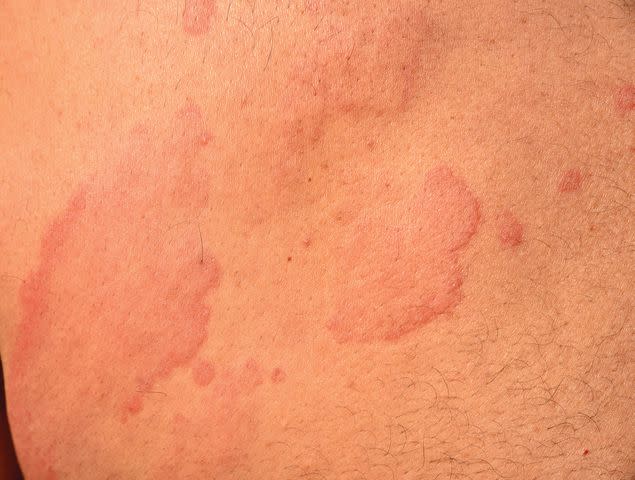
Getty Images
Hives can be an allergic reaction to pet dander, medicine, or pollen. Hives might also develop in response to stress, extreme cold, or excess sweating. The welts are raised and often itchy.
Vitiligo
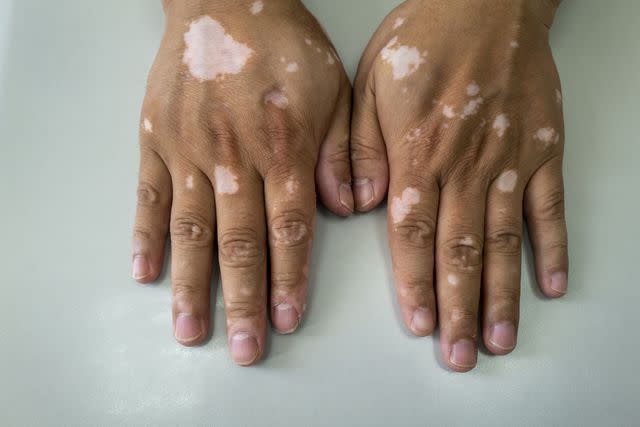
Getty Images
Vitiligo causes white or lighter patches of skin. This skin condition is likely an autoimmune disorder in which your immune system mistakenly attacks melanocytes. Vitiligo is not curable, but treatments can make the skin tone appear more even and stop progression.
Port-Wine Stain
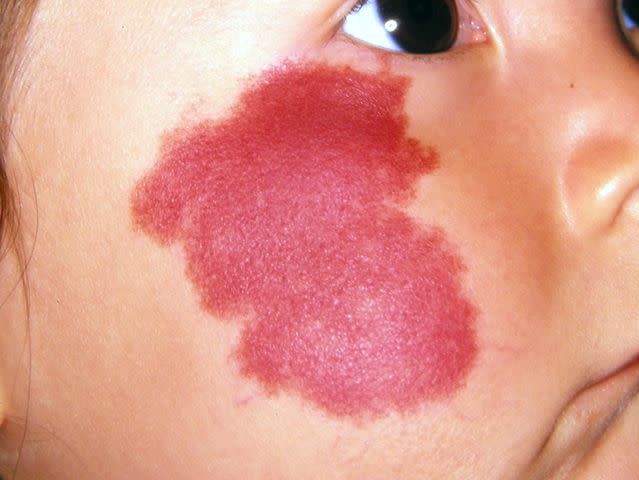
DermNet
Abnormally dilated capillaries (tiny blood vessels) are responsible for this birthmark. Port-wine stains appear as a reddish or purplish discoloration mark that's present at birth, commonly on the face.
Impetigo Scabs
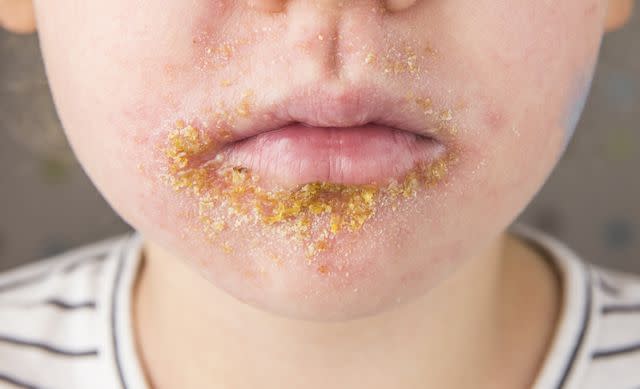
Getty Images
Impetigo, a bacterial skin infection, causes inflamed sores. Scratching these itchy, pus-filled bumps causes them to break open, often causing them to scab over. Impetigo is most common in children.
Eczema Scales
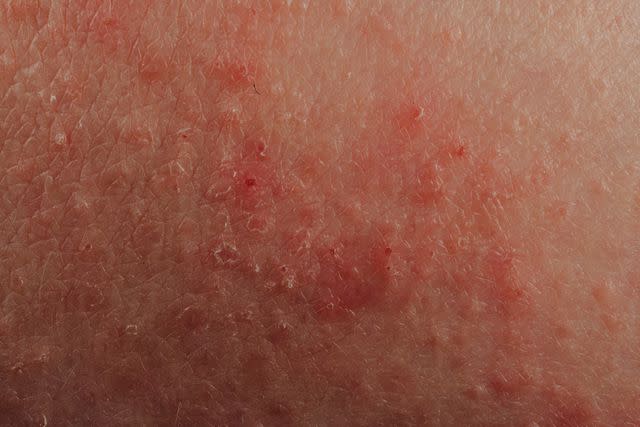
Getty Images
Eczema is an inflammatory skin condition. Several types of eczema cause scaling, including atopic dermatitis and seborrheic dermatitis. Eczema often causes a scaly, itchy, and inflamed rash on different body parts. A mix of genetics and environmental triggers is likely the cause of eczema.
Pityriasis Rosea Scales
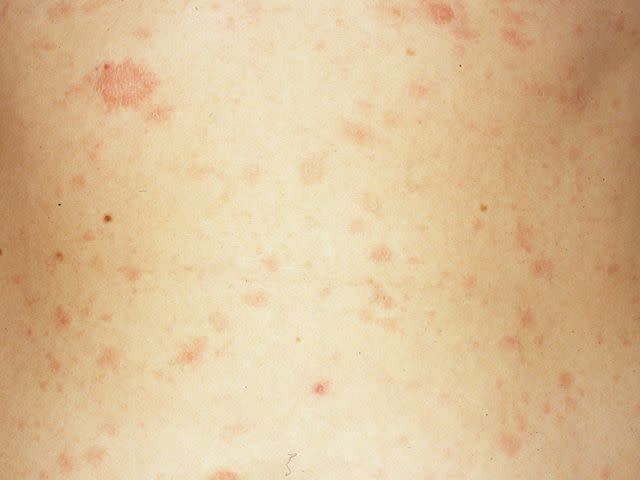
DermNet
This itchy rash starts out as a round or oval-shaped skin lesion on the torso, characterized by scaling. The cause of pityriasis rosea is not fully known, but the reactivation of certain human herpesviruses (HHV) may play a role. The rash usually resolves on its own within eight weeks.
Pressure Ulcers
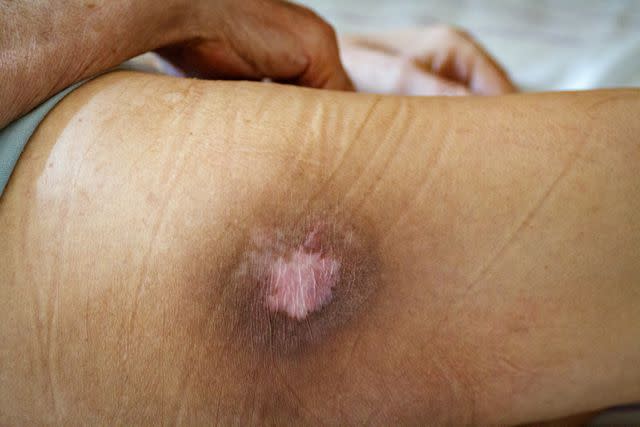
Getty Images
Pressure ulcers (bed sores) are the result of constant pressure or friction on the skin. This pressure exposes the underlying skin tissue and can lead to a severe infection.
Diabetic Ulcers
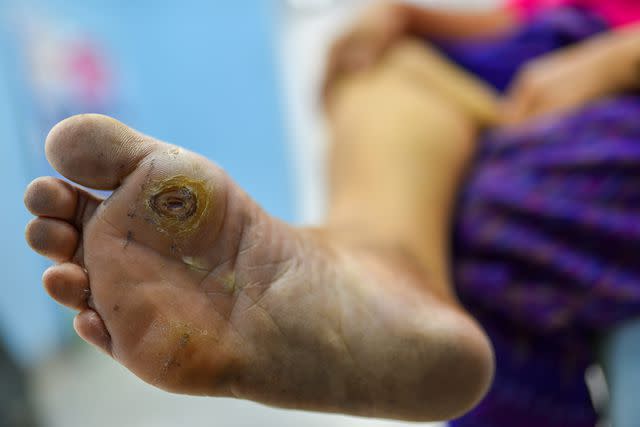
Getty Images
People with diabetes are prone to getting these open sores, typically on the feet. Diabetic ulcers are sometimes painless due to nerve damage.
Keloid Scars
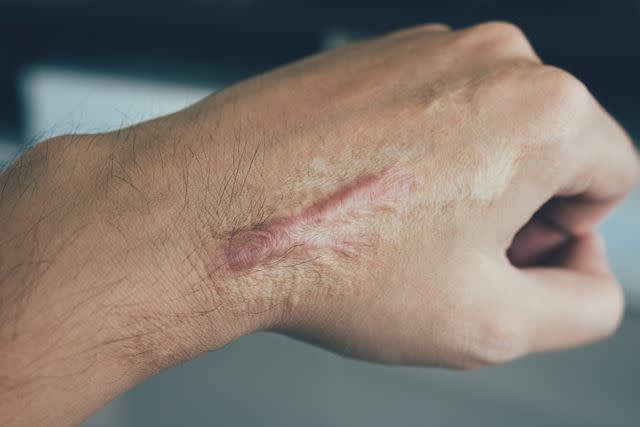
Getty Images
A keloid scar makes the affected skin appear raised or thickened. These scars vary in shape from round to elongated and may itch or cause discomfort. Keloid scars typically grow slowly and expand larger than the initial injury.
What Are Types of Primary Skin Lesions?
There are many types of primary skin lesions, whether they are the result of genetics or an environmental trigger. These include:
Blisters: Little bubbles of liquid form near the top layers of the skin that typically appear due to repeated friction, heat, or a skin condition
Macules: Flat lesions that are usually less than 0.5 cm in size and the same height as the rest of your skin but a different shade (e.g., brown, white, red, or tan)
Nodules: Solid or fluid-filled skin lesions form just under your skin's surface
Papules: Raised, solid skin lesions that grow up to 1 cm in size
Patches: Flat, irregularly shaped skin lesions are different in color than your skin tone and larger than 0.5 cm
Plaques: Rough-textured, raised lesions are bigger than 1 cm
Pustules: A bump no bigger than 1 cm that's filled with pus instead of clear fluid
Wheals: Raised, red or skin-colored welts that develop in response to triggers like bug bites, foods, and medications
What Are Types of Secondary Skin Lesions?
A secondary skin lesion is a primary skin lesion that has changed in some way. These include:
Crusts (scabs): Slightly elevated skin lesions that are made of dried blood or pus and vary in size
Scales: Dry outer skin layers that tend to peel or flake, resulting in a “scaly” appearance
Scars: Skin lesions that repair damage from a skin injury and are usually lighter or pinkish in color
Ulcers: Circular, open wounds that develop when skin tissue is damaged by trauma, pressure, infection, or a lack of blood flow
How Are Skin Lesions Diagnosed?
It's important to see a healthcare provider for a thorough examination, testing, and diagnosis if you have a skin lesion you are concerned about. They'll likely ask about your health history and symptoms before checking out the color, size, shape, and location of the skin lesion.
A healthcare provider may perform a skin lesion biopsy to test for health concerns like psoriasis and skin cancer. They will remove a small sample of the lesion and then examine the cells under a microscope.
How Are Skin Lesions Treated?
The type of skin lesion you have will dictate treatment. A healthcare provider might recommend surgically removing a skin lesion if it looks precancerous or cancerous. Surgery might also be an option for removable lesions that are bothersome, painful, or negatively impact your quality of life. Removal is sometimes an aesthetic choice.
These treatments may include:
Chemical peels: This procedure is commonly used for cosmetic concerns, such as certain types of skin discoloration. A healthcare provider applies a chemical solution to your skin, causing it to peel and remove the lesion over time.
Curettage and electrodesiccation: A healthcare provider will scrape out the skin lesion using a device called a curette. They'll then burn away any remaining cells with high-frequency electrical currents.
Cryotherapy: This involves safely freezing the lesion off with liquid nitrogen. This option is effective for lesions like warts, AK, and some cancerous skin tumors.
Laser therapy: This non-invasive procedure uses a laser beam to target skin cells. Laser therapy can help with birthmarks (vascular lesions), scars, and hyperpigmentation.
Oral medications: A healthcare provider typically prescribes these to promote whole-body healing. This could include a course of oral antibiotics to help treat acne.
Mohs surgery: This specialized technique primarily removes skin cancers, particularly on the face and other sensitive areas. A healthcare provider will remove cancerous tissue layer by layer until no cancer cells are left.
Punch biopsy: A circular tool (the "punch") removes a small, cylindrical piece of the lesion. This is usually done to diagnose and remove smaller lesions, such as suspicious moles.
Shave or skin excision: This technique uses a blade to cut off or shave off the lesion that sticks out (e.g., skin tag).
Simple scissor excision: This technique uses curved surgical scissors to snip off the lesion, especially if it's on or just below the skin. The scissors cut around the lesions to make them easily removable with forceps.
Topical medications: These are medicines that you apply to your skin, which treat the lesion directly. These include topical corticosteroids.
A dermatologist may also recommend home remedies for mild skin lesions. Home remedies include an oatmeal bath and calamine lotion for itchy skin. Make sure you keep your skin clean and moisturized to avoid flaking, cracking, or bleeding. Cover wounds with a bandage and consider pain relievers to alleviate discomfort.
Related: The 4 Types of Rosacea and How To Treat Them
A Quick Review
A skin lesion is an area of skin that's different from the rest. There are many types of skin lesions. Primary lesions (e.g., freckles, acne, and moles) can be present at birth or form later in life. Secondary lesions (e.g., scars, scabs, and ulcers) develop if a primary lesion becomes irritated.
Most skin lesions are not cause for concern, but talk to a healthcare provider if you are worried about one that's changing, growing, or does not show signs of healing. They can let you know if treatment is needed or available.
FAQs
Frequently Asked Questions
1. Do skin lesions go away?
Some skin lesions go away on their own. These include blisters, cold sores, and insect bites. Skin conditions, such as eczema scales and plaque psoriasis, do not go away completely. You can manage these skin lesions with treatment to reduce flares.
2. What skin markings should I worry about?
The American Cancer Society (ACS) advises using the ABCDE rule to spot abnormal skin lesions:
Asymmetry: One side does not match the other side
Border: Irregular edges
Color: A mix of brown, black, pink, red, white, or blue
Diameter: Larger than the size of a pencil eraser in size
Evolving: Changing in color, size, or shape
3. What is the most common lesion seen in dermatology?
Research has shown that acrochordon (skin tag) is the most common skin lesion. A skin tag is a benign (noncancerous) growth of tissue that sticks out from the skin's surface. A healthcare provider can remove skin tags with cryotherapy and cautery.
For more Health.com news, make sure to sign up for our newsletter!
Read the original article on Health.com.

